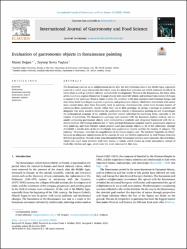| dc.description.abstract | The Renaissance period, as an enlightenment period after the strict Christian rules of the Middle Ages, represents
a period in which many discoveries have been made for about four centuries and which continues its effects in
terms of art as well as political, cultural, and scientific developments. Thanks to the Renaissance, the times when
artists could only express themselves through church rules were left behind, and sections from routine life began
to appear in the paintings. When it comes to daily life, nutrition is the most essential need of human beings, and
since then, foods have begun to appear in pictures, and gastronomic objects, which have intertwined with nature
since ancient times, have been frequently used in paintings. Simultaneously, artists have become masters of
conveying these gastronomic objects, which they use in their paintings, by giving a message in symbols and
allegories. Our study aimed to determine the gastronomic objects in Renaissance painting art and to investigate
the philosophical meanings of the symbols and their current reflections by examining them, especially in the
context of symbolism. The Renaissance paintings were scanned with the document analysis method, and ex amples containing gastronomic objects were evaluated in a symbolic and allegorical framework with the se miotics method. Our findings indicate that 17 early and high Renaissance painters used 61 gastronomic objects in
their paintings, and three Flemish school painters used gastronomic objects in 35 of the collections. Giuseppe
Arcimboldo a notable artist of the era shockingly used gastronomic objects and has the mastery of allegory. The
painting “Vertumnus“ turns into the magnificence of the Roman empire, and “The Gardener/Vegetables in a Bowl”
becomes an allegorical interpretation of the concept of food and fertility represented by God Priapus from two
different perspectives. Overall, it has been determined that Renaissance painters used vegetables like artichokes,
which look much more aesthetic with their leaves, or lemon, which creates an exotic atmosphere, instead of
foods like chicken and eggs, which were the most consumed at that time. | en_US |



















